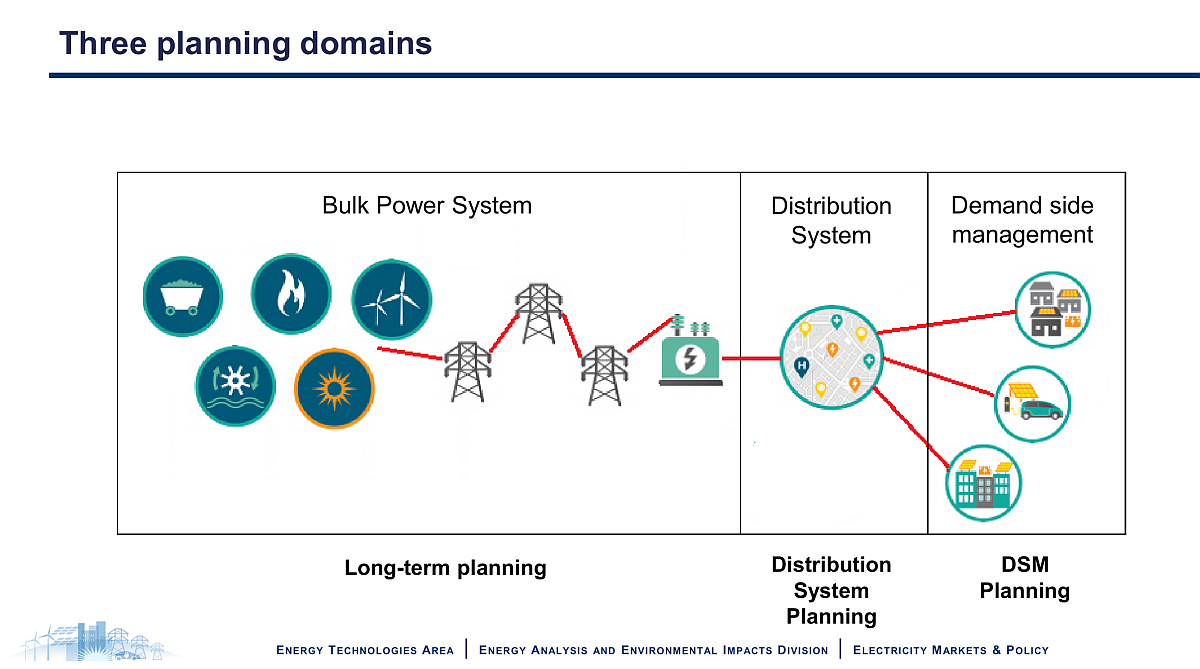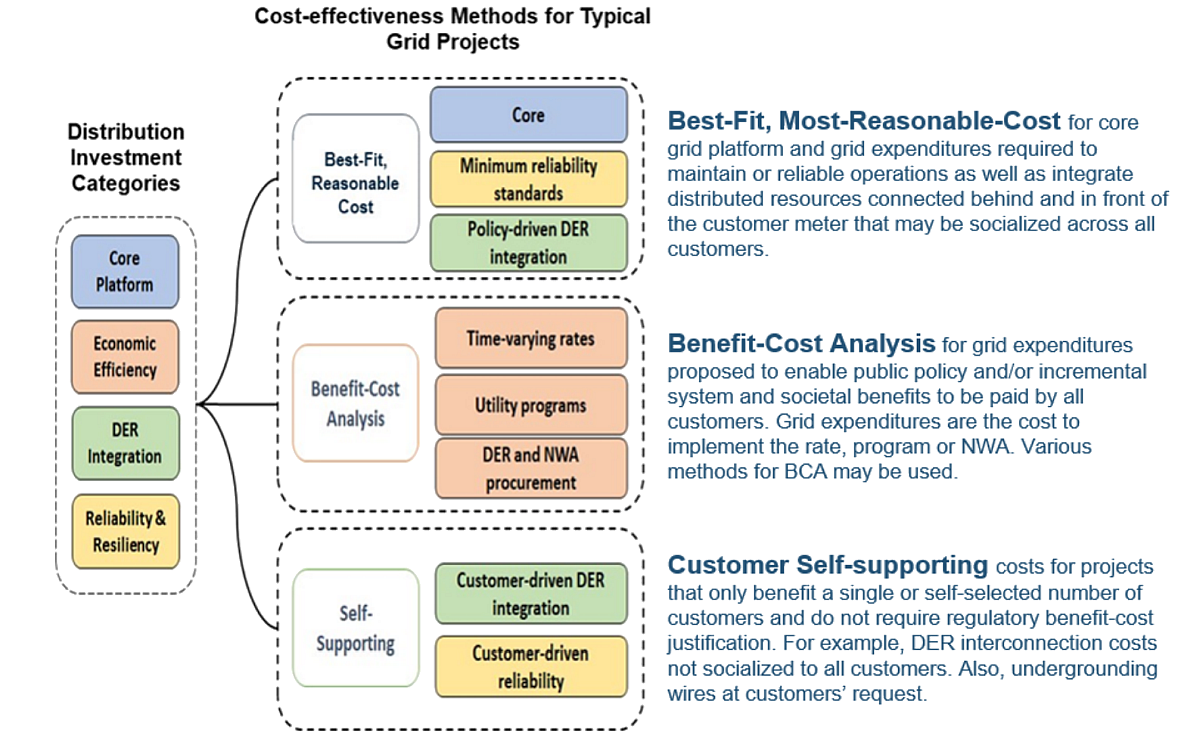
Resource & Distribution Planning
In planning for how they will serve their customers in the future, electric utilities need to answer several fundamental, long-term questions.
- How much electricity will future customers need?
- How will we meet that future need with supply-side and demand-side resources?
- Where will customers need electricity in the future and how much will they need at given times?
- How can we ensure future customers get the electricity they need, where and when they need it?
- How do we do all of this economically, while meeting state policy goals, as well as balancing utility business needs with stakeholder preferences?
The first two questions are answered by Resource Planning. In integrated resource planning (IRP), utilities use economic studies to forecast customer electric load growth and the potential for adoption of efficient technologies. This creates a long-term forecast of the amount of energy their customers will need. The utilities then use models to determine the mix of resources, which include distributed energy resources (DER) – both utility-owned and customer-sited – as well as traditional utility-scale generation that will need to be acquired in the future to meet these needs. This ensures that they will have adequate generation capacity and/or power purchase agreements in place to meet future load growth. Resource planning is common among the Midwest’s utilities, being done in one form or another in most of MEEA’s 13 states. Though the rules and practices are quite different, the IRP processes in Indiana, Michigan and Minnesota are great examples of how Midwest states have developed strong statewide resource planning requirements for utilities.
Questions three and four are answered by Distribution Planning. In distribution system planning (DSP), the focus is on whether the utility will be able to get future energy to its customers and to accommodate future customer-sited resources that will be added to the system. An important aspect of distribution planning is Grid Modernization. Grid modernization is the process of upgrading the aging distribution system using improved technology to be able to meet those future needs and increase resiliency of the network. Grid modernization can be seen as an outcome of distribution planning, with the needs identified in distribution planning informing the grid modernization strategy. In the Midwest, electric distribution planning has been a strong focus in Michigan’s MI Power Grid process and Minnesota’s e21 Initiative. Other notable national examples are California’s Distribution Resources Plan proceedings and New York’s Reforming the Energy Vision initiative.
Though resource planning and distribution planning are distinct processes, they are related to each other. The future customer energy needs identified in the resource planning naturally become inputs into the load forecasts and other criteria of the distribution planning. The results of both processes feed into a third planning process: Demand-Side Management (DSM) planning, as shown in the figure below. It makes sense, therefore, that there is as much alignment as possible between the way these processes value the energy resource options that are available.

How, then, are utilities making these planning and investment decisions? How are potential investments analyzed and compared to one another? How, as the final question above asks, do these investment decisions align with broader state policy goals and the needs and wants of societal stakeholders?
Lowest cost or highest benefits?
There are two ways that utilities can examine the costs of various future investment decisions, known as Benefit-Cost Analysis (BCA) and Least Cost, Best Fit (LCBF). In BCA, the total monetized benefits of possible projects are divided by the total monetized costs – as defined by the BCA test being performed – with a ratio higher than 1.0 indicating that the investment is cost-effective and the scale of that ratio showing how much the benefits outweigh the costs. In LCBF, on the other hand, quantifying the full range of benefits and costs is not necessary – instead the need for the investment is identified and projects that are able to meet that need are compared on the basis of acquisition cost.
Traditionally, LCBF has been the predominant analytical method that utilities used for distribution planning. When the assumption is that the utility is investing in infrastructure needed to maintain reliability, LCBF has been a sufficient approach. However, this assumption is shifting. Current guidance from the Department of Energy calls for LCBF to be done for what are considered “core” components of the grid – investments that bring new capability and functionality to the grid and those that are needed to comply with standards and policy mandates. The core components can be seen as the “platform” that future projects build on. The projects outside of the core are where the expenditures enable bill savings for all customers and provide other policy benefits that are paid for by all customers. These projects, called “applications,” are better served by benefit-cost analysis that can take a deeper look at the benefits from each possible investment. A third category, customer self-supporting projects, are those where the customer opts-in and bears the cost without the need for regulatory cost-effectiveness testing.

Tim Woolf of Synapse Energy Economics makes the case in his November 3 presentation to the MI Power Grid distribution working group that BCA has a wide application across multiple regulatory domains from program design to procurement to all levels of planning and even prudence reviews of past decisions. Maintaining consistency across those processes is vital and using a consistent BCA approach wherever possible is a key component of that. Since BCA provides much more information than LCBF does, LCBF should only be used when necessary.
Though at first look BCA and LCBF seem substantially different, what they have in common is a need to develop plans that allow utilities to meet the relevant policy goals, while aligning with utility system needs and stakeholder preferences. For BCA, this alignment influences the choice of benefit-cost test used for the evaluation and hence the range of benefits and costs that are considered. In LCBF, that alignment influences what needs are being met and thus what projects “fit” and should be considered.
In either case, the framework of the National Standard Practice Manual (NSPM) can be applied to align the planning process with those goals.
Applying the NSPM Framework
The NSPM was developed to provide guidance for BCA, setting forth a framework based on eight foundational principles. Since BCA is used in both resource and distribution planning, the framework can apply to both planning processes. Within the context of distribution planning BCA is still the preferred approach as noted previously, but the NSPM framework can also come into play when considering LCBF analysis for those exceptions when BCA is not possible.
The NSPM Principles. Source: NESP. NSPM for DERs Summary.
|
Principle 1 |
Treat DERs as a Utility System Resource |
|
Principle 2 |
Align with Policy Goals |
|
Principle 3 |
Ensure Symmetry |
|
Principle 4 |
Account for Relevant, Material Impacts |
|
Principle 5 |
Conduct Forward-Looking, Long-term, Incremental Analyses |
|
Principle 6 |
Avoid Double-Counting Impacts |
|
Principle 7 |
Ensure Transparency |
|
Principle 8 |
Conduct BCAs Separately from Rate Impact Analyses |
- Principle 1 of the NSPM states that energy resources should be considered using consistent methods and assumptions across all investment decisions to avoid biasing the decision making. Whether doing resource or distribution planning, using BCA or LCBF, factors such as methods for evaluating risk and reliability, discount rates used and other assumptions and inputs should be used consistently for analyzing each resource or project.
- Principle 2 of the NSPM is that analysis should align with policy goals and objectives. In practice this means that before resource or distribution planning, there needs to be an understanding of what the policy goals of the jurisdiction are. This means taking stock of all relevant state and federal policies, reviewing relevant regulatory decisions and discussing with a range of stakeholders to understand their needs.
- Principle 3 applies mostly to BCA, in that benefits and costs should be considered symmetrically: if a category of cost is included then that category of benefits should also be included. Since LCBF does not require the consideration of benefits, this principle is not directly applicable there. But maintaining consistency in what costs are included and how they are measured between the types of analysis is still important for consistency between the plans.
- Principle 4 asserts that all relevant, material impacts should be considered, including those that are difficult to monetize or quantify. In both BCA and LCBF, this can mean coming up with proxies, scoring rubrics or other weighting methods to provide a means of comparing projects that pass the basic benefit-cost or least-cost screen. Two projects may both pass the screen based on the monetizable factors but there may be non-monetized factors that show one project is better aligned with meeting policy goals.
- Principle 5 says analysis should be forward-looking, which both resource and distribution planning are, and should compare the incremental difference between the project and what would have occurred absent it.
- Principle 6 requires that there should be clear definitions of what impacts are being considered and valued to avoid any double counting. This also applies more to BCA where a broader range of benefit and cost impacts are being considered, as compared to LCBF where acquisition cost is the primary screen. However, it’s also relevant to LCBF in that the needs that are identified and the way the project fit is established should also be clearly defined in the planning process and applied consistently to the possible projects.
- Transparency, Principle 7, is fundamental to engagement in and trust of any utility planning process. All relevant assumptions, methodologies and results should be documented and available for review and input from stakeholders.
- Finally, Principle 8 of the NSPM puts forth the understanding that cost-effectiveness and rate impacts are fundamentally different analyses and should be conducted separately. This can also apply to LCBF, where projects are considered on the basis of filling an identified need rather than whether benefits outweigh the costs. Making core investments in distribution infrastructure will impact rates that utility customers pay but the extent of that rate impact is a substantially different analysis from the project planning decision and should be conducted separately.
Holistic Planning
Resource planning and distribution planning are closely related. Within both planning processes is the need to make informed, prudent investment decisions. Because the processes are so closely related, the analyses that are used need to work from the same playbook. Whether the decision calls for least cost, best fit analysis or benefit cost analysis, the analyses should be done under a consistent and thoughtful framework to ensure that the results of one planning process are relevant and complementary to the other. Regulators in the Midwest are recognizing this. For example, the Michigan PSC opened an ongoing docket (U-20633) directing Staff to refine planning parameters, especially for forecasting the need for future DER integration, reliability needs and to evaluate non-wires alternatives. The goal of the docket, as noted in the 2020 staff report, is to “better align electric distribution plans with integrated resource plans to develop a cohesive, holistic plan and optimize investments considering cost, reliability, resilience, and risk.” But beyond those metrics, the MPSC Order in U-20147 (& U-21122) digs into the deeper questions of how distribution planning can address customer energy affordability and equity. Public comments in that case from business and municipal associations, environmental and consumer advocates, the state attorney general and the public provide a spectrum of opinions on how the commission can address these issues as they continue to evaluate utility distribution plans.
Breaking down the planning silos and creating a holistic plan to optimize future investments in both energy resources and how available resources get distributed is essential to making sure that investments are made in a way that is best for not only the utility system, but also utility customers, society in general and the environment. The guidance documents from DOE and the National Standard Practice Manual, and the Michigan and Minnesota examples above, can help utilities, regulators and stakeholders to better understand how BCA and LCBF processes are related. Since it was created to guide benefit cost analysis across a broad range of regulatory contexts, using the NSPM framework to guide consistent statewide resource and distribution planning processes can improve both, including cases where LCBF is used because BCA isn’t possible. This will help make sure those processes produce compatible outcomes that will drive the energy landscape of the states and the Midwest region toward the goals that are being set for decarbonization while continuing to meet customer energy needs.